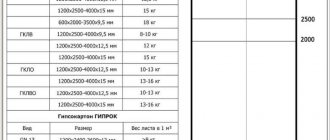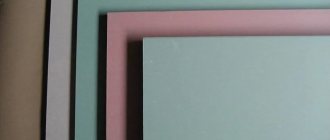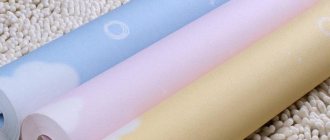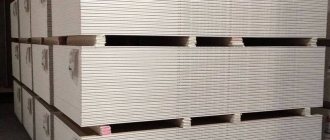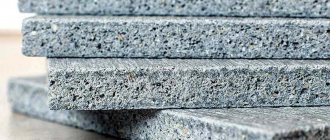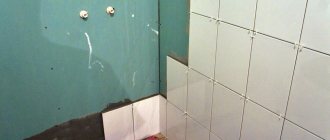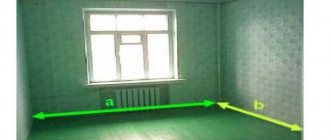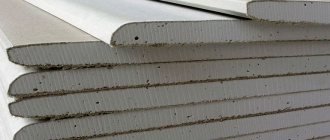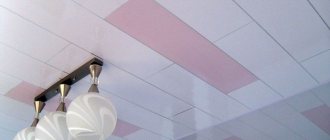Why know the weight of drywall
To determine the mass, we take the sheet area - 1 m2. The weight also depends on its parameters: thickness, area and properties. It happens:
- Ordinary (gypsum board)
- Moisture resistant (GKLV)
- Fire resistant (GKLO)
- Moisture and fire resistant (GKLVO)
Regular or standard - used for indoor work. Humidity should not exceed 70-75%.
Moisture resistant – allows you to work in damp areas. They can cover walls and ceilings in the bathroom and kitchen.
Fire Resistant - Can be used as secondary fire protection.
The weight of drywall is worth knowing in order to:
- Correctly calculate the load on the frame to which the cladding will be attached, and also decide how many fasteners will be required
- Understand whether you have the strength to do the installation yourself or ask someone
- Calculate what the load on transport will be during transportation of the material
- Decide how many loaders will be needed to bring in all the sheets
The characteristics of the material are as follows:
- specific gravity about 1200 – 1500 kg/m3
- thermal conductivity is in the range of 0.21-0.32 W/(m*K)
- strength with a thickness of up to 10 mm is approximately 12-15 kilograms.
How much does a sheet of drywall weigh?
Drywall is used to form additional structures indoors: partitions and small architectural forms in the interiors of buildings. Wall and ceiling cladding can be covered with various types of finishing. The only exception is ceramic tiles due to the heavy load.
Enterprises produce three varieties, their properties are distinguished by the color of the cardboard:
- bodily - standard (gypsum plasterboard);
- blue – moisture resistant (GKLV);
- red – fireproof (GKLO).
Gypsum sheet sizes
The weight of the gypsum board is related to its area and thickness. All over the world there are generally accepted standards of dimensions:
- Length – from 2 to 4 m.
- Width – from 1.2 to 6 m.
- Thickness from – 6 to 24 mm.
Depending on its purpose, it must be of a certain thickness. To create arches and small architectural forms, 6.5 mm is used; 9.5 mm cladding is installed on suspended ceilings; 12-12.5 mm is used on walls. In some cases it reaches 24 mm.
How much does the leaf weigh?
It is important to take this into account when installing a suspended ceiling and horizontal hanging volumetric structures, since the mass of the gypsum board will be a direct load on the supporting frame.
By multiplying the height, width and thickness of the slab, the volume of gypsum is obtained. The product of these two indicators makes it possible to find out what the mass of the desired piece is.
| Size, m | Thickness, mm | ||
| Weight, kg | |||
| 6 | 9,5 | 12,5 | |
| 1.2x2.0 | 12 | 18 | 23 |
| 1.2x2.5 | 15 | 22 | 29 |
| 1.2x3.0 | 18 | 27 | 35 |
The weight of a standard sheet of drywall will differ slightly from moisture-resistant and fire-resistant cladding. This is due to various additives to the structure. To find the exact figure, correction factors are used:
- K1 = 0.01 – takes into account cardboard;
- K2 = 0.01 – moisture-resistant stabilizers;
- K3 = 0.015 – fire-resistant additives.
How to determine mass?
Let’s say that to install cladding in a bathroom, you need to install moisture-resistant Knauf slabs measuring 2500x1200x12.5 mm on the ceiling. The specific gravity of gypsum ranges from 760–780 kg/m3. The volume will be equal to 2.5x1.2x0.0125 m = 0.0375 m3. The average specific gravity is taken to be 770 kg/m3. The calculation takes into account K1=0.01 and K2=0.015.
Using the data obtained, we obtain the weight: 0.0375 m3 x 2300 kg/m3 + (0.0375 x 770) x 0.01 + (0.0375 x 2300) x 0.015 = 29 kg. Using this calculation method, you can always find out how much drywall weighs.
Knauf products are of high quality. Along with the German manufacturer, Gyproc occupies a significant segment in the Russian building materials market. The corporation has 65 factories; mineral raw materials of excellent quality are extracted in more than 75 quarries. Giprok offers building systems that meet Russian requirements in the field of safety and hygiene.
The cost depends on the size of the sheet, its thickness and purpose (type):
| Firm | Length, width, mm | Thickness, mm | View | Price, rubles |
| Knauf | 2500x1200 | 12,5 | GKL | 218 |
| 3000x1200 | 285 | |||
| 2500x1200 | GKLV | 318 | ||
| GKLO | 358 | |||
| 9,5 | GKL | 189 | ||
| Gyproc | 15 | -//- | 375 | |
| 9,5 | GKLV | 448 |
Nuances of installing gypsum boards
For vertical fencing indoors, a frameless method is used, fastening to wooden sheathing and metal profiles. For fastening directly to the walls, use sheets of minimum thickness - 6 mm.
This decision is made when the curvature of the fences is slight. The vertical surface with deflections of no more than 3 mm per 1 meter of length is carefully leveled, convex irregularities are removed.
Gypsum putty is applied to the back side of the cladding in large lumps, then pressed against the wall.
Wooden sheathing is formed from slats or thin timber. Joinery products are fastened on vertical planes using dowels. Drywall 9.5 mm thick is fixed with self-tapping screws.
The most common installation method is to attach the gypsum board to a metal profile. The protruding frame allows you to lay insulation mats between the cladding and the wall.
The finishing thickness in this case is 12.5 mm; 9.5 mm slabs are used to install a suspended ceiling.
For rooms with high levels of humidity, moisture-resistant plasterboard is used. It is suitable for walls and ceilings in bathrooms, toilets, baths, saunas and swimming pools. Knauf has proven itself in this area with dimensions of 2500x1200x12.5.
Drywall today is very popular as a construction and finishing material. It is convenient to use, durable, practical, and easy to install. Our article is devoted to the features and characteristics of this material, and, in particular, its weight.
Peculiarities
Drywall (another name is “dry gypsum plaster”) is a necessary material for the construction of partitions, sheathing and other purposes. Regardless of the sheet manufacturing company, manufacturers try to adhere to general production principles.
One sheet consists of two sheets of construction paper (cardboard) and a core consisting of gypsum with various fillers.
Fillers allow you to change the properties of drywall: some allow it to be resistant to moisture, others enhance sound insulation, and still others give the product fireproof properties.
Initially, plasterboard was used only for leveling walls - this was its intended purpose; now it is increasingly used as a structural material.
Characteristics
The standard sheet width is 120 cm or, if we convert this to mm, 1200.
Standard sizes provided by manufacturers:
- 3000x1200 mm;
- 2500x1200 mm;
- 2000x1200 mm.
Drywall has a number of advantages:
- Eco-friendly material - does not contain harmful impurities.
- High fire resistance (even with ordinary drywall).
- Easy installation - no need to hire a special team.
Main characteristics of drywall:
- Specific gravity in the range from 1200 to 1500 kg/m3.
- Thermal conductivity is within 0.21-0.32 W/ (m*K).
- Strength with a thickness of up to 10 mm varies around 12-15 kg.
For high-quality repairs, it is preferable to have an idea not only of the options for using drywall, but also of its characteristics.
In construction it differs:
- GKL. The usual type of plasterboard is used to create interior walls, suspended ceilings and structures of different levels, partitions, design elements and niches. A distinctive feature is the gray color of the top and bottom layers of cardboard.
- GKLV. Moisture resistant sheet. Used in the bathroom or kitchen, on window slopes. The moisture-resistant effect is achieved through modifiers in the gypsum core. Has a green cardboard color.
- GKLO. Fire resistant material. It is necessary for installing ventilation or air ducts when covering fireplaces, building facades, and in boiler rooms. Provides increased fire protection. Contains fire retardants in the core. It has a red or pinkish color.
- GKLVO. A sheet that combines moisture and fire resistance. This type is used when finishing baths or saunas. May have a yellowish color.
How much does 1 m2 of different types of sheet weigh?
To answer this question, let’s look at the types of drywall:
- Wall. It has a thickness of 12-12.5 millimeters. The sizes vary: 2000x600 mm, 2500x1200 mm and 3000x1200 mm. The weight of one sheet depends on the size: 15, 37.5 and 45 kilograms, respectively.
- Ceiling. It has a thickness of 9 to 9.5 millimeters. The dimensions are the same as for the wall one. Specific gravity is 11.4, 28.5 and 34.2 kilograms.
- Arched. The thickness of the sheet is about 6.5 millimeters. The size is the same as the previous ones. The specific gravity is 7.8, 19.5 and 23.4 kg.
How much does a 9 mm thick sheet of plasterboard weigh per 1 sq.m? Or how much does a 12 mm thick sheet of drywall weigh per 1 sq.m?
Take a look at the following plate:
| Thickness, mm | Weight of plasterboard sheet, kg |
| 9-9,5 | 7,6 — 10 |
| 12-12,5 | 10-13 |
| 6,5-7 | 5-7 |
The volumetric weight of gypsum boards is calculated using the formula:
weight = thickness of one sheet * 1.35
How much does a sheet of drywall weigh?
Drywall is used to form additional structures indoors: partitions and small architectural forms in the interiors of buildings. Wall and ceiling cladding can be covered with various types of finishing. The only exception is ceramic tiles due to the heavy load.
Enterprises produce three varieties, their properties are distinguished by the color of the cardboard:
- bodily - standard (gypsum plasterboard);
- blue – moisture resistant (GKLV);
- red – fireproof (GKLO).
Gypsum sheet sizes
The weight of the gypsum board is related to its area and thickness. All over the world there are generally accepted standards of dimensions:
- Length – from 2 to 4 m.
- Width – from 1.2 to 6 m.
- Thickness from – 6 to 24 mm.
Depending on its purpose, it must be of a certain thickness. To create arches and small architectural forms, 6.5 mm is used; 9.5 mm cladding is installed on suspended ceilings; 12-12.5 mm is used on walls. In some cases it reaches 24 mm.
How much does the leaf weigh?
It is important to take this into account when installing a suspended ceiling and horizontal hanging volumetric structures, since the mass of the gypsum board will be a direct load on the supporting frame.
By multiplying the height, width and thickness of the slab, the volume of gypsum is obtained. The product of these two indicators makes it possible to find out what the mass of the desired piece is.
| Size, m | Thickness, mm | ||
| Weight, kg | |||
| 6 | 9,5 | 12,5 | |
| 1.2x2.0 | 12 | 18 | 23 |
| 1.2x2.5 | 15 | 22 | 29 |
| 1.2x3.0 | 18 | 27 | 35 |
The weight of a standard sheet of drywall will differ slightly from moisture-resistant and fire-resistant cladding. This is due to various additives to the structure. To find the exact figure, correction factors are used:
- K1 = 0.01 – takes into account cardboard;
- K2 = 0.01 – moisture-resistant stabilizers;
- K3 = 0.015 – fire-resistant additives.
How to determine mass?
Let’s say that to install cladding in a bathroom, you need to install moisture-resistant Knauf slabs measuring 2500x1200x12.5 mm on the ceiling. The specific gravity of gypsum ranges from 760–780 kg/m3. The volume will be equal to 2.5x1.2x0.0125 m = 0.0375 m3. The average specific gravity is taken to be 770 kg/m3. The calculation takes into account K1=0.01 and K2=0.015.
Using the data obtained, we obtain the weight: 0.0375 m3 x 2300 kg/m3 + (0.0375 x 770) x 0.01 + (0.0375 x 2300) x 0.015 = 29 kg. Using this calculation method, you can always find out how much drywall weighs.
Knauf products are of high quality. Along with the German manufacturer, Gyproc occupies a significant segment in the Russian building materials market. The corporation has 65 factories; mineral raw materials of excellent quality are extracted in more than 75 quarries. Giprok offers building systems that meet Russian requirements in the field of safety and hygiene.
The cost depends on the size of the sheet, its thickness and purpose (type):
| Firm | Length, width, mm | Thickness, mm | View | Price, rubles |
| Knauf | 2500x1200 | 12,5 | GKL | 218 |
| 3000x1200 | 285 | |||
| 2500x1200 | GKLV | 318 | ||
| GKLO | 358 | |||
| 9,5 | GKL | 189 | ||
| Gyproc | 15 | -//- | 375 | |
| 9,5 | GKLV | 448 |
Nuances of installing gypsum boards
For vertical fencing indoors, a frameless method is used, fastening to wooden sheathing and metal profiles. For fastening directly to the walls, use sheets of minimum thickness - 6 mm.
This decision is made when the curvature of the fences is slight. The vertical surface with deflections of no more than 3 mm per 1 meter of length is carefully leveled, convex irregularities are removed.
Gypsum putty is applied to the back side of the cladding in large lumps, then pressed against the wall.
Wooden sheathing is formed from slats or thin timber. Joinery products are fastened on vertical planes using dowels. Drywall 9.5 mm thick is fixed with self-tapping screws.
The most common installation method is to attach the gypsum board to a metal profile. The protruding frame allows you to lay insulation mats between the cladding and the wall.
The finishing thickness in this case is 12.5 mm; 9.5 mm slabs are used to install a suspended ceiling.
For rooms with high levels of humidity, moisture-resistant plasterboard is used. It is suitable for walls and ceilings in bathrooms, toilets, baths, saunas and swimming pools. Knauf has proven itself in this area with dimensions of 2500x1200x12.5.
How much does a sheet of drywall weigh?
Drywall today is very popular as a construction and finishing material. It is convenient to use, durable, practical, and easy to install. Our article is devoted to the features and characteristics of this material, and, in particular, its weight.
Why know the weight?
When doing DIY repairs, few people think about the weight of building materials. The sheet of drywall is solid, has a certain size, and if the building does not have a freight elevator, the question arises of how to lift it to the desired floor, bring it into the apartment and, in general, move it.
This also includes the method of transporting materials: whether the trunk of your car can accommodate the required number of sheets, and whether the car can withstand the weight stated by its carrying capacity.
The next question will be to determine the number of people who can handle this physical work.
For large-scale repairs or redevelopment, a larger amount of materials is needed, therefore, transportation costs will already be calculated, since the carrying capacity of transport is limited.
Knowing the weight of the sheet is also necessary to calculate the optimal load on the frame to which the cladding will be attached or the number of fasteners.
For example, if you calculate how much a plasterboard ceiling structure weighs, it becomes clear why you should not neglect determining the weight.
Weight also indicates the possibility or impossibility of bending the sheet to make arches and other decorative elements - the smaller the weight, the easier it is to bend it.
State regulations
Construction is a responsible business, so there is a special GOST 6266-97 that determines the weight of each type of plasterboard sheet. According to GOST, an ordinary sheet should have a specific gravity of no more than 1.0 kg per 1 m2 for each millimeter of thickness; for moisture-resistant and fire-resistant products, the range varies from 0.8 to 1.06 kg.
How much does a package of drywall weigh? Quantity per pack
Now that we've figured out the weight of one sheet, let's see how much a pack weighs.
It is supplied without packaging, with an average quantity of 50-60 sheets. They are stored in packs that stand on a pallet. Then the question arises: how can all this be transported? There is a price tag here. Alternatively, you can rent a truck to move materials without worrying about increased prices due to volume.
Let's take a look at the table:
| Sheet thickness, mm | Sheet size (width - length), mm | Number of sheets per package, pcs | Pack weight, kg |
| 9,5 | 1200-2500 | 66 | 1445 |
| 9,5 | 1200-2500 | 64 | 1383 |
| 12,5 | 1200-2500 | 51 | 1469 |
| 12,5 | 1200-3000 | 54 | 1866 |
| 12,5 | 1200-3000 | 49 | 1727 |
The Gazelle ’s carrying capacity is 1.5 tons, so one package of medium-thick sheets can fit.
KAMAZ has 10 tons, 7-8 packs fit.
The truck has 20 tons, you can transport about 15-16 packages.
We hope that the article will clear up all the points and explain all the subtleties.
So, if you decide to make a renovation, then drywall is what you need. From the main one: plasterboard with a thickness of 12 mm, the weight of the sheet is 10 - 13 kg. The weight of 12.5-thick drywall is about the same. Before purchasing packages, we advise you to calculate the volumetric weight per 1 sq.m. and decide how you will deliver it to where it is required.
How to correctly calculate the quantity for installing drywall on the ceiling and walls of a room?
Before purchasing sheets, be sure to measure the ceiling or walls and calculate the working area. Taking this indicator into account, the number of plasterboard sheets required for repair work is calculated (see the article Correct construction of a plasterboard frame).
A standard sheet has an area of 3 square meters. meters. By manually measuring the walls, you need to calculate their area and subtract the area of windows and doors from the total area. Then the resulting number (if necessary) is rounded up and divided by the area of the standard sheet.
Let's say the height of the walls is 2.7 meters. The size of the room is 2.5 by 3 meters. The size of the window is 1.5 by 1.5, and the door is 2 by 1.5 meters.
Calculate the perimeter of the walls of the room
: (2.5+3)x2=11 meters. We determine the area of the walls: 11x2.7 = 29.7 square meters. meters.
Determining the area of the door
: 2x1.5=3 sq. meters.
Calculate the window area
: 1.5x1.5=2.25 sq. meters.
Working area
: 29.7–(3+2.25)=24.45 square meters.
The area of the walls is divided by the area of the standard sheet: 24.45/3 = 8.15 (sheet).
The correction factor is taken into account!
- for rooms up to 10 sq. meters it is 1.3;
- from 10 to 20 square meters the coefficient is 1.2;
- for large rooms – 1.1.
On a note
. Calculations can be carried out taking into account any size (area) of plasterboard sheet.
For covering a balcony with plasterboard (side height 1.5 meters), small sheets 1.5 meters long and 0.6 meters wide are ideal. Or a standard-width plasterboard sheet three meters long, cut in half.
How to transport drywall correctly so as not to damage it
- Plasterboard sheets are transported only in a horizontal position. They can be stacked or stacked. In this case, the sheets are placed on the pallet with the front side inward.
- This material is quite brittle. Extreme care must be taken when loading and unloading.
- To transport small quantities of drywall, you can use the trunk of a car (after laying timber on it every 30 centimeters) or a small truck.
- In the back of a truck, the sheets must be laid on a clean floor. You cannot place other building materials on top, such as bags of cement or cans of paint. It is best to make a pallet for the sheets from bars, and cover the entire package with wrapping paper or polyethylene on top, thereby protecting the building material from dirt and dust.
Secret devices for conveniently carrying plasterboards
When transferring, a sheet (or two sheets) is held with your free hand. This transportation option is intended for private houses and apartments. For large construction sites, equipped trolleys with supports are more suitable.
How many people do you need to carry?
With all the variety of plasterboard sheets, standard and waterproof types are most often used. Arched ones require the participation of a specialist in installation. But in any case, you can’t do without help. Therefore, feel free to involve at least one or two family members in the transportation and installation. Good luck with your renovation!
Repair Tips:
How much does a sheet of drywall weigh: dimensions, area and weight
To determine the mass, we take the sheet area - 1 m2. The weight also depends on its parameters: thickness, area and properties. It happens:
- Ordinary (gypsum board)
- Moisture resistant (GKLV)
- Fire resistant (GKLO)
- Moisture and fire resistant (GKLVO)
Regular or standard - used for indoor work. Humidity should not exceed 70-75%.
Moisture resistant – allows you to work in damp areas. They can cover walls and ceilings in the bathroom and kitchen.
Fire Resistant - Can be used as secondary fire protection.
The weight of drywall is worth knowing in order to:
- Correctly calculate the load on the frame to which the cladding will be attached, and also decide how many fasteners will be required
- Understand whether you have the strength to do the installation yourself or ask someone
- Calculate what the load on transport will be during transportation of the material
- Decide how many loaders will be needed to bring in all the sheets
The characteristics of the material are as follows:
- specific gravity about 1200 – 1500 kg/m3
- thermal conductivity is in the range of 0.21-0.32 W/(m*K)
- strength with a thickness of up to 10 mm is approximately 12-15 kilograms.
How much does drywall weigh according to GOST?
The specific gravity of GKLVO and GKLO is from 0.8 to 1.06 kilograms.
You can calculate how much a plasterboard structure will withstand, knowing the mass and volume. You should not always rely on GOST.
How much does a package of drywall weigh? Quantity per pack
Now that we've figured out the weight of one sheet, let's see how much a pack weighs.
It is supplied without packaging, with an average quantity of 50-60 sheets. They are stored in packs that stand on a pallet. Then the question arises: how can all this be transported? There is a price tag here. Alternatively, you can rent a truck to move materials without worrying about increased prices due to volume.
Let's take a look at the table:
| Sheet thickness, mm | Sheet size (width - length), mm | Number of sheets per package, pcs | Pack weight, kg |
| 9,5 | 1200-2500 | 66 | 1445 |
| 9,5 | 1200-2500 | 64 | 1383 |
| 12,5 | 1200-2500 | 51 | 1469 |
| 12,5 | 1200-3000 | 54 | 1866 |
| 12,5 | 1200-3000 | 49 | 1727 |
The Gazelle ’s carrying capacity is 1.5 tons, so one package of medium-thick sheets can fit.
KAMAZ has 10 tons, 7-8 packs fit.
The truck has 20 tons, you can transport about 15-16 packages.
We hope that the article will clear up all the points and explain all the subtleties.
So, if you decide to make a renovation, then drywall is what you need. From the main one: plasterboard with a thickness of 12 mm, the weight of the sheet is 10 - 13 kg. The weight of 12.5-thick drywall is about the same. Before purchasing packages, we advise you to calculate the volumetric weight per 1 sq.m. and decide how you will deliver it to where it is required.
5 main types of drywall
It should be borne in mind that plasterboard sheets are available in several types and each is suitable only for use in certain conditions:
- Ceiling plasterboard, used respectively for finishing ceilings;
- Wall plasterboard, more durable, ideal for working with walls; (read an interesting article about the construction of walls from gypsum plasterboard here)
- Moisture-resistant plasterboard, specially designed for rooms with high moisture content (it can be distinguished by the greenish tint of the sheet);
- Fire-resistant plasterboard intended for finishing fireplaces;
- Arched plasterboard, always mounted in two layers and more expensive in price.
Thickness
- The thickness of the plasterboard for the ceiling is 9.5 millimeters, the thickness of the plasterboard for the walls is 12.5 millimeters.
- Thickness varies from 0.65 to 2.4 centimeters. The most commonly used sizes are ceiling (9.5 mm), arch (6.5 mm) and wall (12.5 mm) sizes.
What sizes does a standard sheet come in: choose the length and width
- Standard size of plasterboard sheet: length 2.5 meters, width 1.2 meters, thickness 1.25 centimeters. Such sheets are also used for leveling floors.
- The length can be chosen longer or shorter than the standard. The industry produces sheets ranging in length from two to four meters (in increments of 50 centimeters).
- The choice of width of plasterboard sheets is not so diverse. In addition to the standard width, there is a small gypsum board version of 0.6 meters on the market.
- Small plasterboard sheets are used exclusively for finishing slopes and decorative elements, as well as balconies.
The width of such a sheet is 60 centimeters, and the length can be from 1.5 to 3 meters. Thickness 12.5 millimeters. The sheet weight is 9 kilograms.
How much does 1 sheet of drywall weigh?
The weight of a standard sheet of drywall (width 1.2, thickness 1.25, length 2.5 meters) is on average 29 kilograms (if it was stored in a dry room). GCR is capable of absorbing moisture, so the actual weight may be greater than that declared by the manufacturers.
When determining the weight of plasterboard sheets, you need to rely on the following data (standard width 1.2 meters):
- length two meters: thickness 6 mm - 12 kilograms, 9.5 mm - 18 kilograms, 12.5 - 23 kilograms;
- length two and a half meters: thickness 6 mm - 15 kilograms, 9.5 mm - 22 kilograms, 12.5 - 29 kilograms;
- length three meters: thickness 6 mm - 18 kilograms; 9.5 mm – 27 kilograms, 12.5 mm – 35 kilograms.
How many squares are there in a sheet?
This depends on the size of the specific plasterboard sheet. A standard sheet has an area of 3 sq.m.
How many sheets are there in a package on a pallet (pallet)?
- The number of gypsum board sheets with a thickness of 12.5 mm in a pack is 50-52 pieces
- The number of gypsum board sheets 9 mm thick in a pack is from 60 to 65 pieces
Main manufacturers and price per sheet and per square meter
Three main manufacturers have proven themselves quite well. The sheets they sell are of equal quality: Knauf (Germany), Lafarge (France), Rigips (Poland).
Approximate prices for drywall of different brands and sizes:
- standard plasterboard sheet for wall finishing
- (size 1.2 x 2.5 meters, thickness 12 mm centimeter) - price per sheet of plasterboard is 215 rubles and 71 rubles price per 1 sq.m.
(Knauf, Germany), 225 rubles per sheet and 75 per 1 sq.m. (Lafarge, France), 333 rubles per plasterboard sheet and 111 rubles per square meter (Rigips, Poland); - How much does moisture-resistant gypsum board cost (standard) - 282 rubles cost of a sheet of drywall and 94 rubles price per square (Knauf), 307 rubles per sheet of plasterboard and 102 rubles per 1 m2.
(Lafarge), 338 rubles per sheet and 112 rubles per square meter (Rigips); - What is the price of a ceiling plasterboard sheet (1.2 meters wide and 9.5 centimeters thick) - 261 rubles per sheet and 72.5 per square meter (length 3 meters, Knauf), 170 rubles per sheet and 70 rubles.
for 1 sq.m. (length 2 meters, Lafarge), 225 rubles per sheet and 75 rubles per 1 sq.m. (length 2.5 meters, Rigips); - The cost of a sheet and a square meter of arched plasterboard (1.2 meters wide, 6.5 centimeters thick) is 394 rubles per sheet and 109 rubles per square meter (length 3 meters, Knauf), 491 rubles per sheet and 136 rubles.
for 1m2. (length 3 meters, Lafarge), 268 rubles per sheet and 89 rubles per 1 sq.m. (length 2.5 meters, Rigips); - fire-resistant plasterboard (standard) – 242 rubles per sheet and 80 rubles per 1 sq.m. (Knauf), 153 rubles per sheet and 51 rubles per 1 sq.m. (Lafarge), 187 rubles per sheet and 62 rubles per 1 sq.m. (Rigips).
How to correctly calculate the quantity for installing drywall on the ceiling and walls of a room?
Before purchasing sheets, be sure to measure the ceiling or walls and calculate the working area. Taking this indicator into account, the number of plasterboard sheets required for repair work is calculated (see the article Correct construction of a plasterboard frame).
A standard sheet has an area of 3 square meters. meters. By manually measuring the walls, you need to calculate their area and subtract the area of windows and doors from the total area. Then the resulting number (if necessary) is rounded up and divided by the area of the standard sheet.
Let's say the height of the walls is 2.7 meters. The size of the room is 2.5 by 3 meters. The size of the window is 1.5 by 1.5, and the door is 2 by 1.5 meters.
Calculate the perimeter of the walls of the room
: (2.5+3)x2=11 meters. We determine the area of the walls: 11x2.7 = 29.7 square meters. meters.
Determining the area of the door
: 2x1.5=3 sq. meters.
Calculate the window area
: 1.5x1.5=2.25 sq. meters.
Working area
: 29.7–(3+2.25)=24.45 square meters.
The area of the walls is divided by the area of the standard sheet: 24.45/3 = 8.15 (sheet).
The correction factor is taken into account!
- for rooms up to 10 sq. meters it is 1.3;
- from 10 to 20 square meters the coefficient is 1.2;
- for large rooms – 1.1.
On a note
. Calculations can be carried out taking into account any size (area) of plasterboard sheet.
For covering a balcony with plasterboard (side height 1.5 meters), small sheets 1.5 meters long and 0.6 meters wide are ideal. Or a standard-width plasterboard sheet three meters long, cut in half.
How to transport drywall correctly so as not to damage it
- Plasterboard sheets are transported only in a horizontal position. They can be stacked or stacked. In this case, the sheets are placed on the pallet with the front side inward.
- This material is quite brittle.
Extreme care must be taken when loading and unloading. - To transport small quantities of drywall, you can use the trunk of a car (after laying timber on it every 30 centimeters) or a small truck.
- In the back of a truck, the sheets must be laid on a clean floor.
You cannot place other building materials on top, such as bags of cement or cans of paint. It is best to make a pallet for the sheets from bars, and cover the entire package with wrapping paper or polyethylene on top, thereby protecting the building material from dirt and dust.
Secret devices for conveniently carrying plasterboards
When transferring, a sheet (or two sheets) is held with your free hand. This transportation option is intended for private houses and apartments. For large construction sites, equipped trolleys with supports are more suitable.
